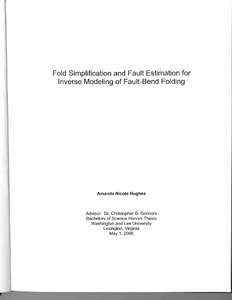| dc.rights.license | In Copyright | en_US |
| dc.creator | Hughes, Amanda Nicole | |
| dc.date.accessioned | 2023-10-20T18:00:59Z | |
| dc.date.available | 2023-10-20T18:00:59Z | |
| dc.date.created | 2006 | |
| dc.identifier | WLURG038_Hughes_thesis_2006 | |
| dc.identifier.uri | https://dspace.wlu.edu/handle/11021/36471 | |
| dc.description.abstract | It has been long recognized that many folds observed in the field and in seismic reflection data are created as stratigraphic layers are displaced over nonplanar fault surfaces. As material is moved over a bend in a fault, the rock layers are forced to fold, a process termed "fault-bend folding." Fault-bend folding has been geometrically characterized and forward modeled, but a rigorous inverse model does not exist. An inverse model is currently being developed that uses a genetic algorithm to find the fault shape over which displacement of material fault could have created the observed structure given the geometric and kinematic constraints of fault-bend folding. As part of the development of the inverse model, this study aims at creating a reasonable initial population of faults for the genetic algorithm by observing the fold shape and estimating the fault shape based on a few aspects of the fold. By integrating a few simple structural geology concepts into the prediction of fault shapes from fold shapes, a program was created that produces a more intelligent initial population of folds for the genetic algorithm. The algorithms developed can be separated into two categories: simplification and description of the observed fold and fault shape estimation. Fold simplification is accomplished by an area-based line simplification algorithm. The properties of the fold are observed (line length, spatial X and Z locations) and dip domains are described. The fault shape is then estimated by using the information observed about the fold and dip domains to predict the initial X and Z location of the fault, length of the fault, number and location of fault bends, and
slope of fault segments, and the input slip is also estimated. The algorithms were tested on four synthetic fault-bend fold models that were generated by the forward modeling program. The tests explored the estimated fault shapes generated by varying the fault parameter range, line simplification, and complexity independently and together. It was observed that the line simplification is the most sensitive parameter to change, and that variations in fold shape and complexity make it such that there is no single optimal value for any of the parameters used. As such, it was determined by using the test functions developed that by varying all of these parameters within a specified range it is possible to generate an initial population of faults with the desired variability around the known fault shape. Future work includes testing and refining the algorithms and testing their most effective implementation into the inverse model. | en_US |
| dc.format.extent | 67 pages | en_US |
| dc.language.iso | en_US | en_US |
| dc.rights | This material is made available for use in research, teaching, and private study, pursuant to U.S. Copyright law. The user assumes full responsibility for any use of the materials, including but not limited to, infringement of copyright and publication rights of reproduced materials. Any materials used should be fully credited with the source. | en_US |
| dc.rights.uri | http://rightsstatements.org/vocab/InC/1.0/ | en_US |
| dc.subject.other | Washington and Lee University -- Honors in Geology | en_US |
| dc.title | Fold Simplification and Fault Estimation for Inverse Modeling of Fault-Bend Folding | en_US |
| dc.type | Text | en_US |
| dcterms.isPartOf | WLURG038 - Student Papers | en_US |
| dc.rights.holder | Hughes, Amanda Nicole | en_US |
| dc.subject.fast | Folds (Geology) | en_US |
| dc.subject.fast | Faults (Geology) | en_US |
